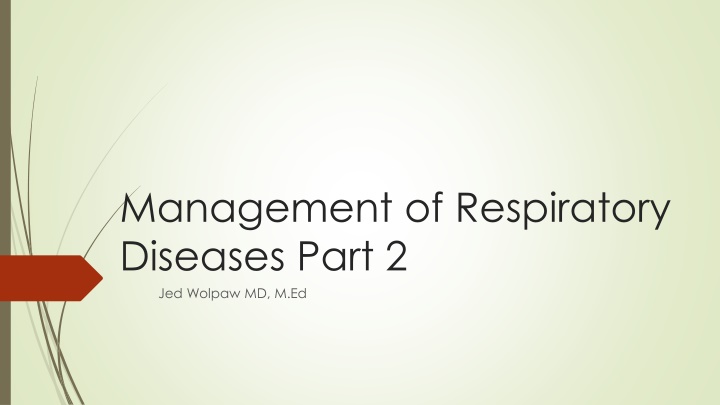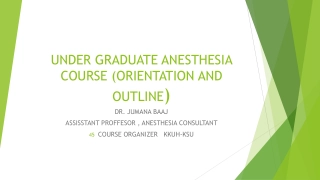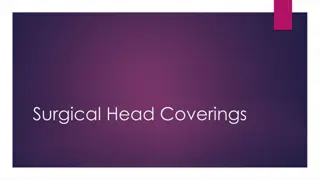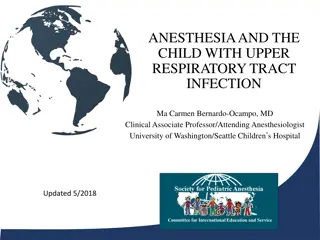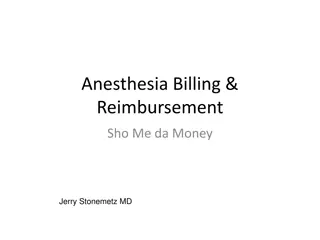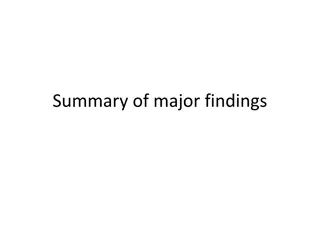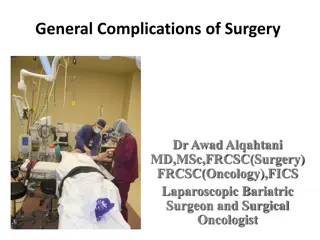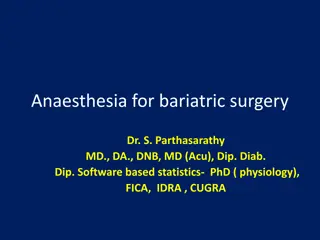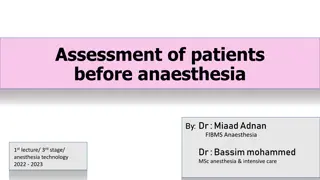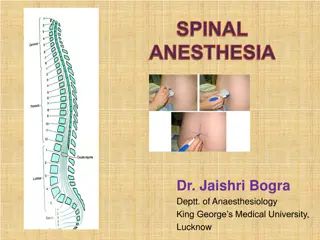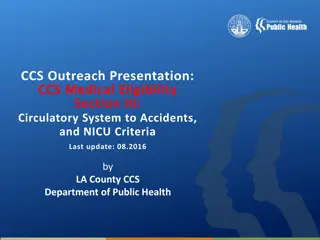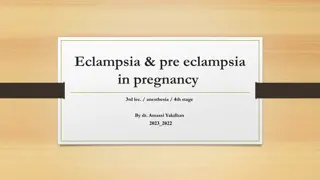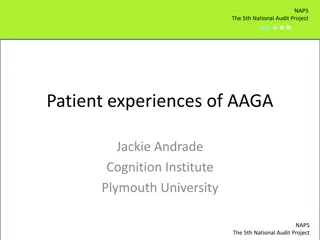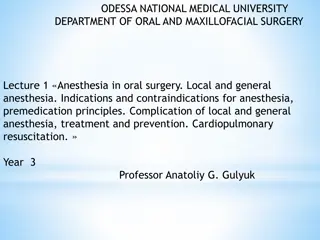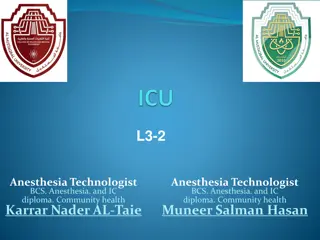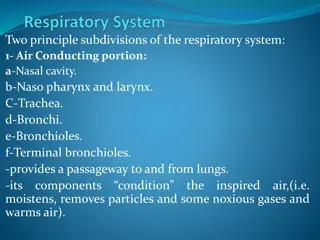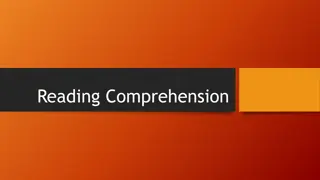Comprehensive Management of Respiratory Diseases: Anesthesia and Surgical Considerations
This detailed content discusses the management of respiratory diseases in surgical settings, covering aspects such as preop and post-op care, anesthetic techniques, monitoring, concerns like bronchospasm and auto-PEEP, and special considerations for thoracic and non-thoracic surgeries. The information provided is essential for healthcare professionals dealing with patients with respiratory issues undergoing various surgical procedures.
Download Presentation

Please find below an Image/Link to download the presentation.
The content on the website is provided AS IS for your information and personal use only. It may not be sold, licensed, or shared on other websites without obtaining consent from the author.If you encounter any issues during the download, it is possible that the publisher has removed the file from their server.
You are allowed to download the files provided on this website for personal or commercial use, subject to the condition that they are used lawfully. All files are the property of their respective owners.
The content on the website is provided AS IS for your information and personal use only. It may not be sold, licensed, or shared on other websites without obtaining consent from the author.
E N D
Presentation Transcript
Management of Respiratory Diseases Part 2 Jed Wolpaw MD, M.Ed
Outline Management of the Patient with Respiratory Disease Initial Evaluation (done in part 1) Preop preparation (done in part 1) Intraoperative management Post-op management Special issues with thoracic surgery (OLV) Special issues with pneumonectomy
Anesthetic management Intraoperative Management Monitoring Choice of Anesthesia Anesthetic Techniques: Nonpulmonary Surgery, Thoracic and Pulmonary Surgery, One- Lung Ventilation Most of this is for patients with COPD. With restrictive lung disease main issues are hypoxia, rapid desaturations, high airway pressures, inability to extubate
Non-Thoracic surgery for patients with respiratory disease
Monitors Standard If severe disease will want a-line for ABG and likely concomitant cardiac disease May be large gap between ETCO2 and PCO2
Concerns Auto-peep/dynamic hyperinflation Bronchospasm Interference with hypoxic pulmonary vasoconstriction Risk of PTX Laparascopic surgery
Auto-peep/dynamic hyperinflation Look at your ETCO2 curve, if sloped and not peaking, check flow time curve Keep in mind for cause of hypotension, increased airway pressures Increase I:E ratio and recheck flow time curves
Bronchspasm Pre-existing hyper reactive airways Risk for severe bronchospasm with intubation Use lidocaine IV, consider spraying cords w lido, fentanyl (need much larger dose than we usually use to reliably block reflexes, 5mcg/kg or more), consider ketamine Deep is better than light
Hypoxic pulmonary vasoconstriction Patients with emphysema already have impaired HPV Anesthesia makes it worse Can lead to hypoxia, increasing dead space and gap between ETCO2 and PCO2, check ABG periodically
Risk of PTX Patients may have bullae, can burst with positive pressure Keep in mind for sudden hypotension, tachycardia, difficulty ventilating
Laparascopic surgery Buildup of CO2 can be hard to deal with, can t increase RR much because need to exhale May need to ask surgeons for periodic desufflation to breathe off CO2 Already impaired diaphragmatic function can be worse with insufflation
Anesthetic technique If possible avoiding intubation and maintaining spontaneous ventilation is good to decrease risk of bronchospasm, infection, prolonged intubation Regional, epidural, spinal Unless not possible (e.g. can t lie flat, can t stop coughing, very anxious, etc)
Sedatives Caution with opiates and versed, especially in combination Common oral board situation is bad COPD and bad anxiety in preop TALK TO THE PATIENT
Neuraxial If possible, use an epidural in COPD patients Lower risk of post-op PNA and lower mortality LINK to article: http://www.ncbi.nlm.nih.gov/pubmed?term=21796055&holding=jhumlib&otool=jhumlib Epidural analgesia is associated with improved health outcomes of surgical patients with chronic obstructive pulmonary disease. Van Lier F, van der Geest PJ, Hoeks SE, van Gestel YR, Hol JW, Sin DD, Stolker RJ, Poldermans D. Anesthesiology. 2011 Aug;115(2):315-21.
What about peripheral nerve blocks Good idea with a caveats Interscalene block and supraclavicular block have high risk of phrenic block Paralyzes ipsilateral diaphragm 25% reduction in FVC Worse on R side (more lung)
Induction Consider ketamine If major concern for bronchospasm consider inhaled induction Etomidate can increase airway resistance
Maintenance Inhaled anesthetics are bronchodilators (N20) is not Propofol is not, but doesn t harm Caution with opioids Lung protective ventilation but can t go too high on RR Avoid ongoing paralysis if possible to avoid post-op problems
POST-OP Extubation Pain Management Respiratory Therapy
Extubation Maximize chances of success Complete reversal of NMB-use adductor pollicis rather than periorbital Cautious use of opiates Consider bronchodilators first Give time to eliminate inhaled anesthetic, takes longer in COPD 2/2 VQ mismatch Consider extubating to bipap Criteria Baseline oxygenation and ventilation Usual criteria, but may be harder to meet
Pain management Epidural, peripheral nerve catheter multimodal: gabapentin, Tylenol, toradol if possible
Respiratory therapy Goal is to prevent atelectasis, maintain lung expansion Incentive spirometry IPPV no better than IS, more complications Pulmonary toilet Chest physio Early mobilization: Reduces incidence of pulm complications, reduces hospital and ICU stay, improves mortality
Thoracic surgery All of the above apply plus: One lung ventilation Double lumen vs bronchial blocker Placement Phsyiology Dealing with hypoxia Exchanging at the end of the case Special considerations for pneumonectomy Complications Chest tubes Mediastinoscopy Compression of innominate Reflex bradycardia
One lung ventilation 3 options DLT Bronchial blocker Single lumen in a mainstem bronchus-rare Advantages of DLT Easy to insert, easy to suction, can intermittently ventilate both lungs Advantages of bronchial blocker Can isolate just part of a lung if necessary, no need to replace tube at end
How to place a DLT Most common-Fiberoptically Scope in bronchial lumen, find carina, orient yourself, place scope in desired mainstem (usually left) and then thread tube over scope Then come out, go down tracheal lumen, find carina, go down R mainstem and look for RUL bronchus, then inflate bronchial cuff and see if it herniates out of carina Go down bronchial side and make sure you are not occluding anything Look at distance on tube when you think you are at carina with bronchial tip initially, if 28cm, probably not carina. If 12-22, probably fine Distance from mouth to cords 8-10cm, from cords to carina about 10-14cm depending on height If you are in at least 12-14cm you are not going to extubate
Confirming with auscultation Oral board alert
Physiology of OLV When supine, blood flow is 55% R lung, 45% L lung When R side down it is 75% R lung When L side down it is 70% L lung Hypoxic pulmonary vasoconstriction increases this to 85-90% for R lung and 80-85% for Left lung
Hypoxia Should not start at 100% FIO2, see podcast episode 3 If hypoxic, increase FIO2 If still hypoxic at 100%: PEEP to ventilated lung (but can make it worse) CPAP to non-ventilated lung if possible Resume two-lung ventilation of necessary and possible Last resort: clamp pulmonary artery
End of case ETT Options are: Extubate Leave DLT in place (but most ICUs won t accept this) Extubate over an exchanger and reintubate with single lumen Extubate completely and reintubate with single lumen: If easy airway Can place laryngoscope or video laryngoscope, visualize cords, and keep view while removing DLT and replacing with SLT
Pneumonectomy complications Arryhthmias: 25% of patients Usually afib PE: up to 7%, usually from LE but can be from pulm artery stump, more common on R Intracardiac shunting: from either elevated RH pressure or change in cardiac geometry w IVC flow directed at PFO Dyspnea, platypnea (SOB worse standing, better lying) Cardiac herniation Through defect in pericardium with torsion of heart Hypotension, shock, chest pain, SVC syndrome Lactation: From irritation of anterior thoracic nerves
Chest tubes A chest tube placed to suction causes increased risk for cardiac herniation Can use chest tube without suction Some surgeons don t use chest tubes at all Special chest tubes that don t allow suction
Mediastinoscopy Can compress innominate artery leading to apparent cardiac arrest if monitors are on R arm. Can also cause cerebral ischemia Put pulse ox and a-line on R and non-invasive cuff on left to identify compression and warn surgeon Can also get reflex bradycardia from compression of trachea, vagus nerve, great vessels Sudden hypotension could also be massive hemorrhage
